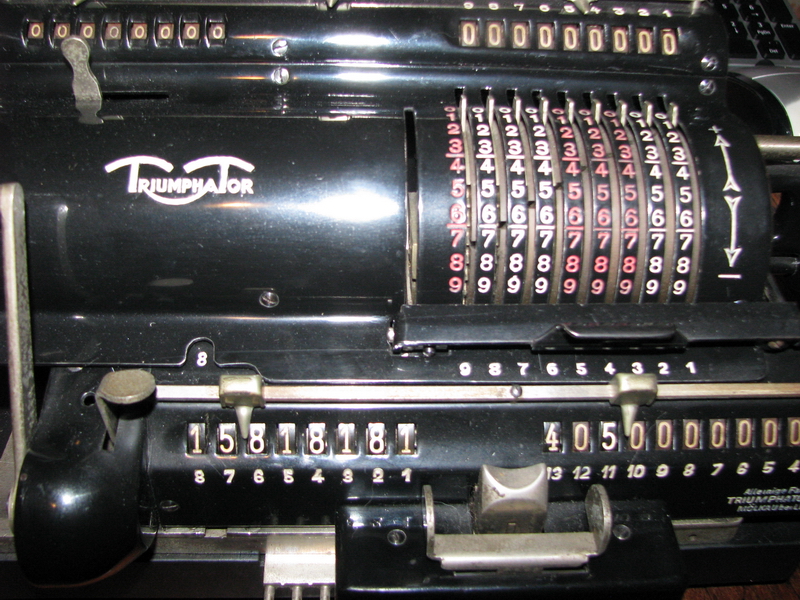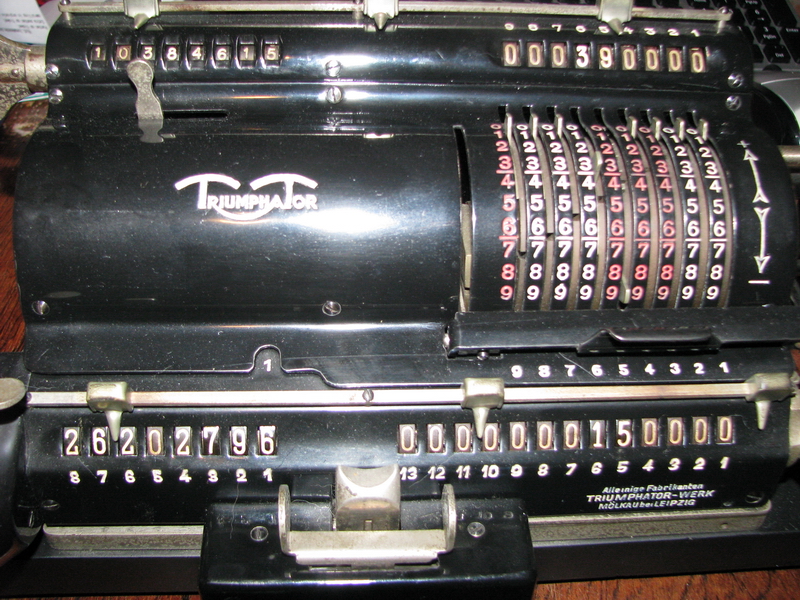Triumphator CB
Another machine from the former collection of fellow Belgian collector Freddy Haeghens. It was sold in a large lot of calculators at - let's call it a well-known auction house for technical antiques. No-one noticed that the machine was "somewhat special". According to Triumphator catalogs, the name of the machine is model "CB", and is was made uniquely in 1928. What distinguishes it from the regular model C is the extra revolution counter at the top left of the machine. There is a manual switch for the revolution counter direction, and both counters always count in the same direction.According to the promotional material from Triumphator, the machine has the following features:
Capacity is given as 9 x 8+8 x13, weight is 8kg and dimensions 30 x 13 x 11 cm.
The serial number of this machine is 57352.
I have never seen another one, or pictures of one.
One wonders what the second counter register could be used for - proofs of a calculation? A memory/grand total register for the result makes some sense, but for the counter register? If anyone has any ideas, I'd love to hear about them.
And such is the power of the internet, that the day after I posted this appeal, Robert Mařík, Czech collector and professor of mathematics, as well as the owner of a fantastic youtube channel, sent me his ideas on how it could be used. First some pictures:
A leaflet with the all of the Triumphator range at the end of the 20s in the Rechnerlexikon
Another leaflet kindly provided by the Borgmeyers gives the detail mentioned above (but in Spanish):

And then finally, some pictures of the machine itself:




And "under the hood":

It can be recognized in the following two pictures, taken from the back of the machine, that the drive to the top counter register is from the right side, and that the system used for pivoting the arm that directs the one-tooth counting gear to the correct position as the carriage moves from left to right is quite similar to that of the Brunsviga J and MH - there is a pivot point on the base of the machine.


A very interesting machine, and I am very happy it found its way to my collection.
Now, a note on how to possibly use this thing.
Let's say we have three numbers - 348, 405 and 422, and we want to do some statistics on them:
Set 348 in the setting register, and multiply by itself (note the red 2 in the top counter register - I used shortened multiplication, which only works properly if you have ten's carry in the counter register):

Clear the top register, set 405 in the setting register, and multiply by itself - you will find 405 in the top register, the sum of 348 and 405 in the bottom register (753), and the sum of the squares ((285129) in the result register:

Now we continue with 422:

And in this way we can continuously sum a series of numbers and their squares, which would be very useful for calculating variances and standard deviations in statistics. nOw, to be sure, this can also be done with onyl one counter register, but then you have to count off each digit yourself, and you have no positive proof anywhere that you did not miscount.
Another use is to do continuous sums of products. You can also do this with any mechanical calculator, but the Triumphator CB allows to keep track of the individual terms as well, which could be useful.
E.g.: we want to calculate 348/22 + 405/39, we set up the dividend in the result register at the left, so we can set up the divisor in the setting register in such a way that the first digit of the quotient will be in position 8 in the counter registers (no shortened division if we want to avoid mess...)-

then we set the machine to subtraction, and divide. The quotient (15,818181) will be in both counter registers.

Now comes the clever part - we clear the result and top counter register, set up the second dividend in the setting register, and transfer it to the result with a positive turn.

We clear the input to zero and revert the last turn,

then set up the divisor, and divide.

Now the bottom counter register contains the sum of the quotients, whereas the top register contains only the last term, which would otherwise not have recorded.
What more could you possibly want for the small price difference with the regular Triumphator C? Clearly companies did not see it that way, as this appears to be the ony example left in the world!
